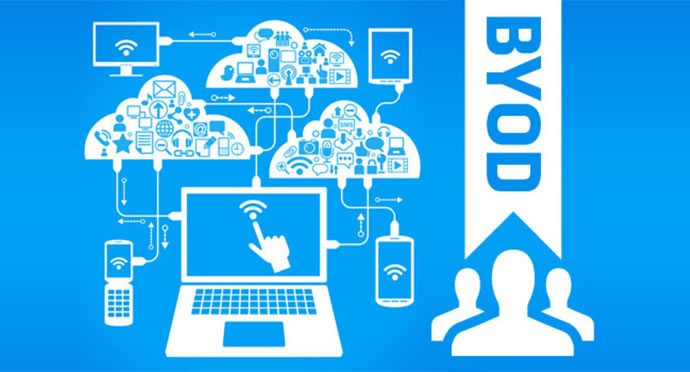Of all the trends in technology today, BYOD, short for “bring your own device,” is among the most popular. This makes sense considering nearly 100 percent of employed individuals own at least one mobile device that they bring to work on a daily basis. Naturally, people want to use their device(s) at the office or wherever it is they work.
Accessing mission critical information, including eLearning and other online learning resources, with an employee's own device whenever and wherever they may be reduces a barrier that limits adoption and engagement.
IBM MobileFirst gives an excellent definition of BYOD: “Bring your own device (BYOD) is an IT policy where employees are allowed or encouraged to use their personal mobile devices—and, increasingly, notebook PCs—to access enterprise data and systems. There are four basic options, which allow:
- Unlimited access for personal devices.
- Access only to non-sensitive systems and data.
- Access, but with IT control over personal devices, apps and stored data.
- Access, while preventing local storage of data on personal devices.” 1

Well over half of all companies promote one of these four types of bring-your-own-device policies. There are good reasons for this. First, if employees are supplying their own devices, they are responsible for any associated costs. Depending upon the size of a company, this can lift a hefty financial burden. Second, most individuals are experts at operating their personal mobile devices and need no assistance in this area, which frees up valuable training time. A BYOD policy also makes it easy for employees to access corporate data and online training materials, which can increase productivity. Of all the benefits listed here, increased productivity usually pleases company leaders most. Some organizations choose to implement BYOD solely for the purpose of augmenting productivity.
Dell Study Shows Link Between BYOD and Increased Productivity
A bring-your-own-device policy can have a major bearing upon an employee’s productivity or lack thereof. A study by Dell Software, which was conducted with the help of at least 1500 “IT decision makers,” revealed BYOD’s impact upon productivity. Scott Campbell, writer for CRN, reported on the study. He wrote, “(According to the study), more than two-thirds of businesses see boosts in employee productivity and customer response time by letting employees bring their own devices to work, and more than half of companies feel they would be at a competitive disadvantage without BYOD.”2 Other employee benefits, according to Campbell, included more flexible schedules, heightened creativity, innovation, and morale, and better workplace collaboration. Roger Bjork, the director of enterprise mobility solutions for Dell, said, “It (BYOD) is working. And for companies that approach this with a well-thought out plan, it works better. It's not surprising, but it is refreshing to see.”
Sources besides Dell are finding that BYOD equates to higher-performing employees. The Aberdeen Group, for example, is of the opinion that a bring-your-own device policy is essential to the effectiveness and productivity of a workforce. In his article Are BYOD Workers More Effective?, Tom Kanishige quoted Andrew Borg, Aberdeen Group analyst: “Although the temptation (in a BYOD study) is to measure specific processes and estimate the number of minutes shaved off routine activity, it's advisable to look at process workflows that would otherwise have long bottlenecks without ubiquitous mobile access.3 In this article, Kanishige mentioned that BYOD programs were also making positive changes at Eaton Corp. He noted that Eaton’s CIO Justin Kershaw measured iPad worker productivity gains and found that what “used to take days and weeks in the legacy process…(now takes) hours and minutes.”
Clearly, BYOD has the capacity to lighten the workload of employees and free-up time that could be spent on other tasks. However, it’s probable that companies seeing this level of benefit from a bring-your-own-device policy have, as Dell’s Roger Bjork said, approached it with a thorough plan.
The Cold, Hard Facts: BYOD Statistics
Many fairly new technology trends do not have sufficient statistical data to legitimize them to company leaders who need more information before implementing them. This is not the case with BYOD. Compared to other specific trends in technology, BYOD has a sea of statistics. Mobile Authentication Today did an excellent job summarizing them in the article BYOD SWOT and Statistics4. The piece brings to light some facts about BYOD that all business owners should be aware of. It states:
- “81% of employed adults use at least one personally owned electronic device for business.
- 59% of employees surveyed use mobile devices to run line-of-business applications (Ibid).
- 74% of companies allow BYOD usage in some manner.
- 50% of companies have experienced a data breach due to inadequate device security.
- 71% of companies state that they support and/or tolerate BYOD. Only 29% have forbidden BYOD.
- The number of connected devices per employee (was) 3.3 in 2014.
- 43% of companies have unveiled a BYOD security strategy.
- 50% of companies that apply BYOD have the employees bear all costs for this.
- The number of tablets that companies offer their employees will increase by 50% a year.
- 73% of those who use tablets at the workplace surf the web.
- 69% of those who use tablets do so to read and write e-mail.
- 67% of those who use tablets carry out distance working.”
Numbers don’t lie. The fact that 7 out of 10 companies enable BYOD proves that companies are benefiting from this trend and that it is likely here to stay. The question is why do thirty percent of companies forbid BYOD?
Companies Forbid BYOD for Security-Related Reasons
Compared to its benefits, the downsides of a bring-your-own-device policy are few but significant. Since these issues may be preventing 30-or-so percent of companies from jumping on the BYOD bandwagon, they are worth taking a look at. First and foremost, a bring-your-own-device policy can increase the chances of breaches in security. This threat is most to blame for any company’s hesitation to embrace such a policy.
Related Reading: Employee Training in Cyber Security: 4 Tips & Techniques
BYOD employees have increased access to enterprise data. This is the main security risk associated with BYOD. It can be tough for some IT departments to control this level of access, which can leave a company in a vulnerable position. Also, there is the issue of a personal device with access to sensitive data becoming lost. The bottom line is that company leaders want to remain in control of important data, which is why some shy away from BYOD.
Another study reported by CRN shed some light on the number of people who are genuinely concerned about BYOD being a security hazard. In his article BYOD and Security: The Biggest Threat of All, Robert Westervelt explained that a “survey of 3,300 IT professionals was conducted by B2B International and Kaspersky Lab in 2012. Survey respondents were from 22 countries and all indicated they influenced IT security policy. The survey found that 34 percent of respondents considered mobile devices a serious threat to business, and 55 percent said they were thinking more about the security of corporate smartphones and tablets than they did last year.”5 The study concluded that most individuals who worry about the security ramifications of a bring-your-own-device policy still choose to implement one.
Security issues aside, many company leaders avoid implementing BYOD for fear of employees blurring the lines between work life and personal life. This is a valid concern. After all, those who work on personal mobile devices can check professional emails one minute and shoot text messages to friends and family the next. This is another key reason why some organizations are against BYOD.
It’s understandable that leaders want to retain control over company data and limit employees’ personal communications at work. However, forbidding BYOD may not be as effective as these leaders hope it will be. A no-BYOD policy won’t stop employees from bringing devices to work and using them for professional and personal purposes. What it will do is erase the devices’ visibility, which only hurts a company in the long run. Dave Martin, vice president and CSO at Hopkinton, said, “Ask anyone who says they don't have BYODs to review their logs—I guarantee they'll find Mobile Safari. Disallowing BYODs just pushes them underground where you lose visibility. I'd rather see BYODs and deal forensically with risks than try to convince myself that I can block them outright. Experience has shown that's a failed strategy; users find a way in. But if you're too permissive, you're open to data loss. We are unable to lock down BYODs in the same way, so we need to be smarter about how we use them."6 Again, a plan is the secret to ensuring a successful and safe BYOD policy, which workforces demand in one way or another.
The Importance of a BYOD Implementation Plan
Although BYOD is a great thing—a miracle for some companies—it doesn’t come about effortlessly. At least, it shouldn’t. Roger Bjork, director of enterprise mobility solutions for the Dell Software group, said, “We encourage (companies) to have a plan and not just let BYOD happen… developing a plan is a good step.”7 Part of this first step is crafting a BYOD agreement checklist to share with employees. Such a list brings much-needed clarification to any policy. Here is a list created and recommended by the Security for Business Innovation Council:
- “Ensure that end users are responsible for backing up personal data
- Clarify lines of responsibility for device maintenance, support and costs
- Require employees to remove apps at the request of the organization
- Disable access to the network if a blacklisted app is installed or if the device has been jail-broken
- Specify the consequences for any violations to the policy.”8
Creating an agreement checklist is essential and can lessen any initial confusion or trepidation surrounding a new policy. Another step in a BYOD implementation plan directly addresses the security concerns so many people share, and it is launching a learning management system (LMS) with available mobile learning access.
Can an LMS Remedy BYOD Security Issues?
A learning management system is capable of a great many things, but its main reason for existence is to facilitate training. These systems are designed to give people access to training materials and company data. Full-featured eLearning platforms also come equipped with social learning features that allow users to access their social media accounts and engage in realtime chat, web conferencing, etc. LMS administrators can store whatever information they wish on a social learning platform. This means they can omit sensitive materials if they so desire. They can also limit what data a user may access on a personal device (or any device, for that matter). Quite simply, an LMS gives administrators what it is they really want and need to make BYOD work: control over enterprise data.
Mobile learning, or mLearning, is another important aspect of a learning management system. Mobile learning and BYOD are enhanced by one another. mLearning, which is simply learning that takes place via a mobile device, can happen apart from a bring-your-own-device policy. Long before BYOD was a trend, mobile learning was taking place on company-owned devices. However, mobile learning is more effective with BYOD. With mLearning, which is enabled by an LMS or another social learning platform, employees can securely access whatever data has been stored on the cloud, 24 hours a day, 7 days a week, any place, from any device with a Web browser and a connection to the Internet. mLearning is convenient no matter whose device is being used. Still, it is most convenient on a personal device and is best enhanced by a bring-your-own-device policy.
As is the case with any policy, there are pros and cons to BYOD, but many companies find that its assets far outweigh its liabilities. Company leaders deliberating about implementing a bring-your-own-device policy may want to take the plunge and see what happens. Worst-case scenario is that there is a breach in security or employees allow their personal lives to encroach too closely on the workplace. In these cases, the policy would simply be cancelled. Best-case scenario is that employee productivity is increased, creativity and innovation are heightened, collaboration is fostered, and worker satisfaction is enhanced. There’s only one way to find out what scenario will result, and that is to give BYOD a chance.
References:
- http://www.ibm.com/mobilefirst/bring-your-own-device/byod.html
- http://www.crn.com/print/news/mobility/240146736/study-byod-brings-employee-productivity-gains.htm
- http://www.cio.com/article/2396832/consumer-technology/are-byod-workers-more-productive-.html
- http://www.mobileauthenticationtoday.com/byod-swot-and-statistics/
- http://www.crn.com/news/security/240145933/byod-and-security-the-biggest-threat-of-all.htm
- http://searchsecurity.techtarget.com/feature/BYOD-security-strategies-Balancing-BYOD-risks-and-rewards
- http://www.crn.com/print/news/mobility/240146736/study-byod-brings-employee-productivity-gains.htm
- http://searchsecurity.techtarget.com/feature/BYOD-security-strategies-Balancing-BYOD-risks-and-rewards




